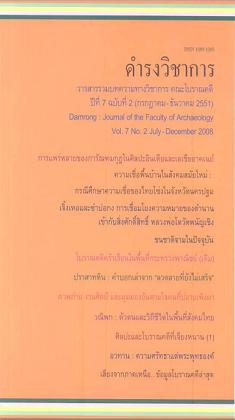KHMER TEMPLES: THE UNFINISHED MOTIFS
Keywords:
ศาสนสถาน, ลวดลาย, ปราสาทเขมรAbstract
Many Khmer stone temples are decorated with magnificent, but incomplete, motifs. The unfinished nature of these motifs can be viewed as a reflection of their society and culture, in that time period. The selected temples that I used as case studies are; Prasat Muang Tum, Prasat Ban Pluang, Prasat Ta Muan Thom, Prasat Puey Noi, Prasat Phnomwan and Prasat Phnom Rung. All of these temples were built in the style of Baphuon-Angkok Wat and date between the tenth and eleventh centuries.
The core results of my study are threefold
1. The craftsmen put a high significance on the direction that the stonework faced. Front facing and eastern facing are the most important sides, and these have completed decorations. The back and western facing stonework is left unfinished, as these directions were deemed less important.
2. The craftsman ‘ranked’ the architecture as per levels of nobility, for example, the main sanctuary is the most significant and highest ranked (the most noble building) and this complex is completely decorated with the most beautiful decorations and motifs. No other building ranks so nobly, or received such artisanship.
3. The unfinished motifs reflect both the quality of the craftsmen and the associated management system. We can say that the quality deteriorates proportionately with the quantity of craftsmen associated with any particular motif (many craftsmen working together can create magnificent motifs, but a lesser number of craftsmen working in a specific area create lesser quality motifs). A process called ‘caravan work’ is when craftsmen are forced to abandon their current motifs to work on a new site, thus leaving the previous motif Incomplete. This process of ‘caravan work’ was the root cause behind the deterioration in quality of many motifs.
References
โจวต้ากวาน, บันทึกว่าด้วยขนบธรรมเนียมประเพณีของเงินละ, แปลโดย เฉลิม ยงบุญเกิด, พระนคร : ชวนพิมพ์, 2510
รุ่งโรจน์ ธรรมรุ่งเรือง, ปราสาทขอมในดินแดนไทย ความเป็นมาและข้อมูลด้านประวัติศาสตร์ศิลปะ, กรุงเทพฯ : มติชน, 2548.
ศิลปากร, กรม. จารึกในประเทศไทย เล่ม 3 อักษรขอม พุทธศตวรรษที่ 15-16, กรุงเทพฯ : กรมศิลปากร, 2529.
ศิลปากร, กรม. จารึกในประเทศไทย เล่ม 4 อักษรขอม พุทธศตวรรษที่ 17-18, กรุงเทพฯ : กรมศิลปากร, 2529.
สมิทธิ์ ศิริภัทร์ และมยุรี วีระประเสริฐ, ทับหลัง, กรุงเทพฯ : กรมศิลปากร, 2533.
สุภัทรดิศ ดิศกุล, หม่อมเจ้า, ศิลปะขอม, กรุงเทพฯ : องค์การค้าของคุรุสภา, 2539.
สุริยวุฒิ สุขสวัสดิ์, หม่อมราชวงศ์. ปราสาทเขาพนมรุ้ง ศาสนบรรพตที่งดงามที่สุดในประเทศไทย, พิมพ์ครั้งที่ 4, กรุงเทพฯ : มติชน, 2539
สุริยวุฒิ สุขสวัสดิ์, หม่อมราชวงศ์, ปราสาทหินและทับหลัง, กรุงเทพฯ : โครงการสืบสานมรดกวัฒนธรรมไทย, 2542.
Downloads
Issue
Section
License
บทความนี้เป็นผลงานของข้าพเจ้าแต่เพียงผู้เดียว และ/หรือเป็นผลงานของข้าพเจ้าและผู้ร่วมงาน ตามชื่อที่ระบุในบทความจริง และเป็นผลงานที่มิได้ถูกนำเสนอหรือตีพิมพ์ที่ใดมาก่อน





